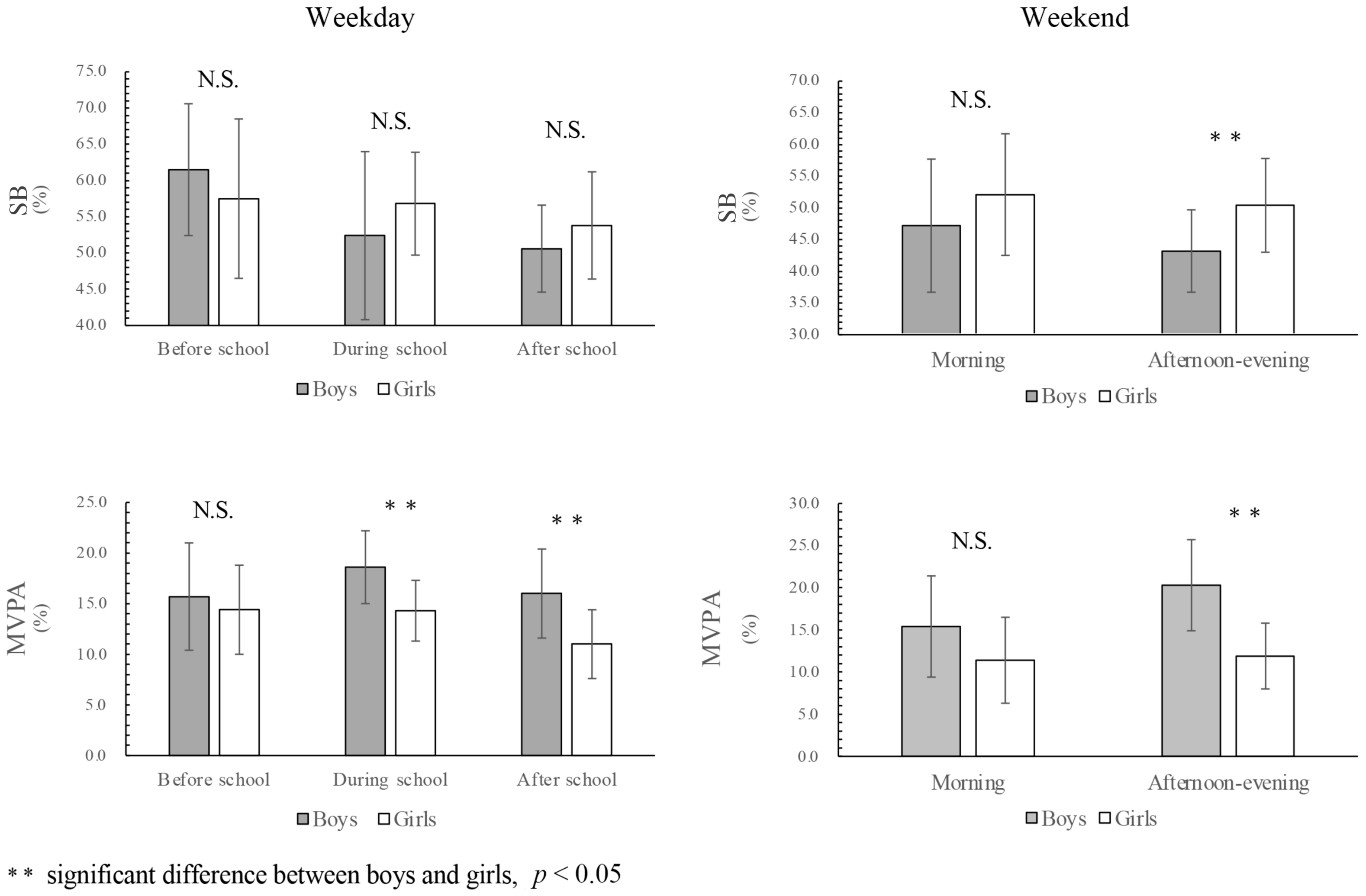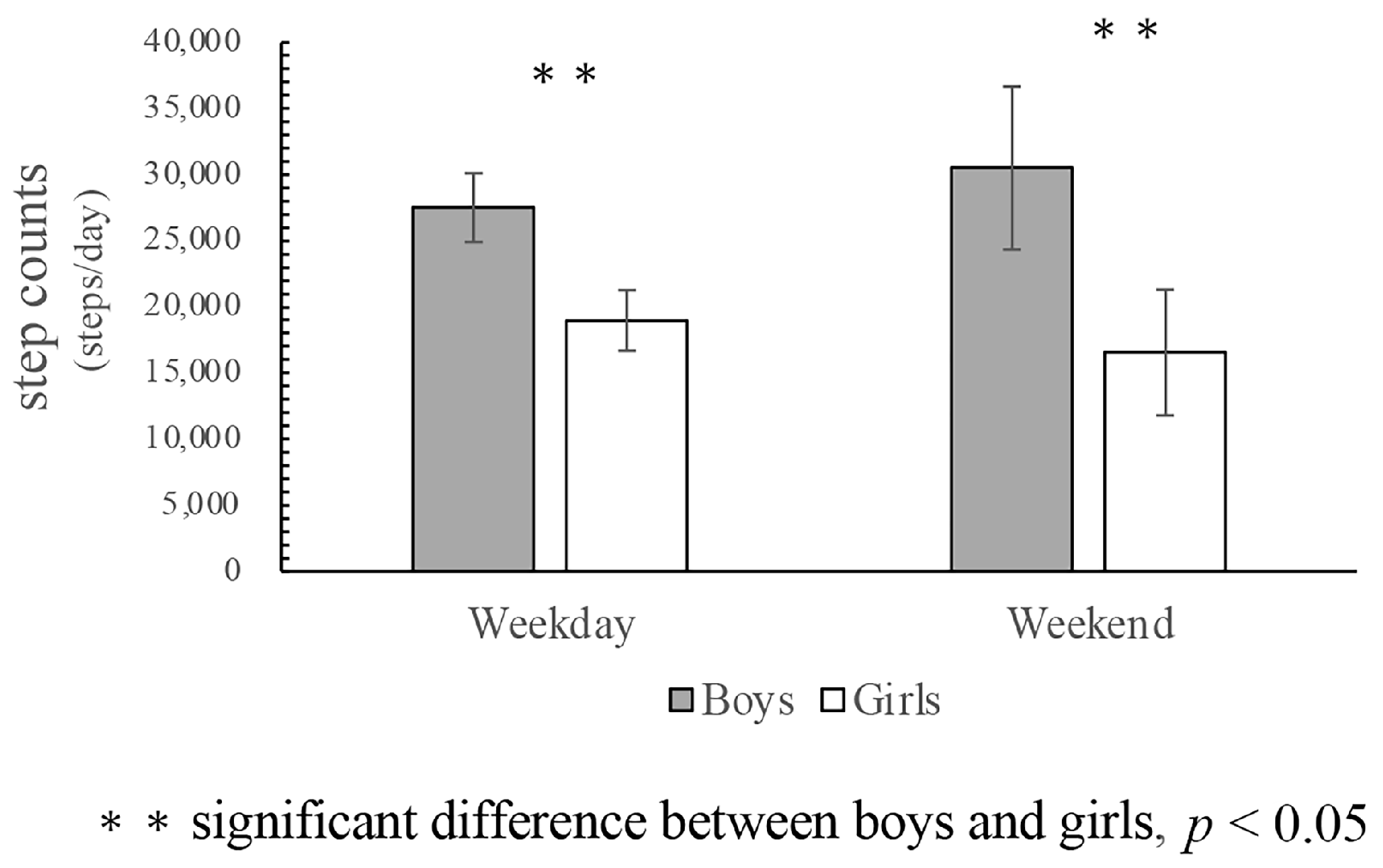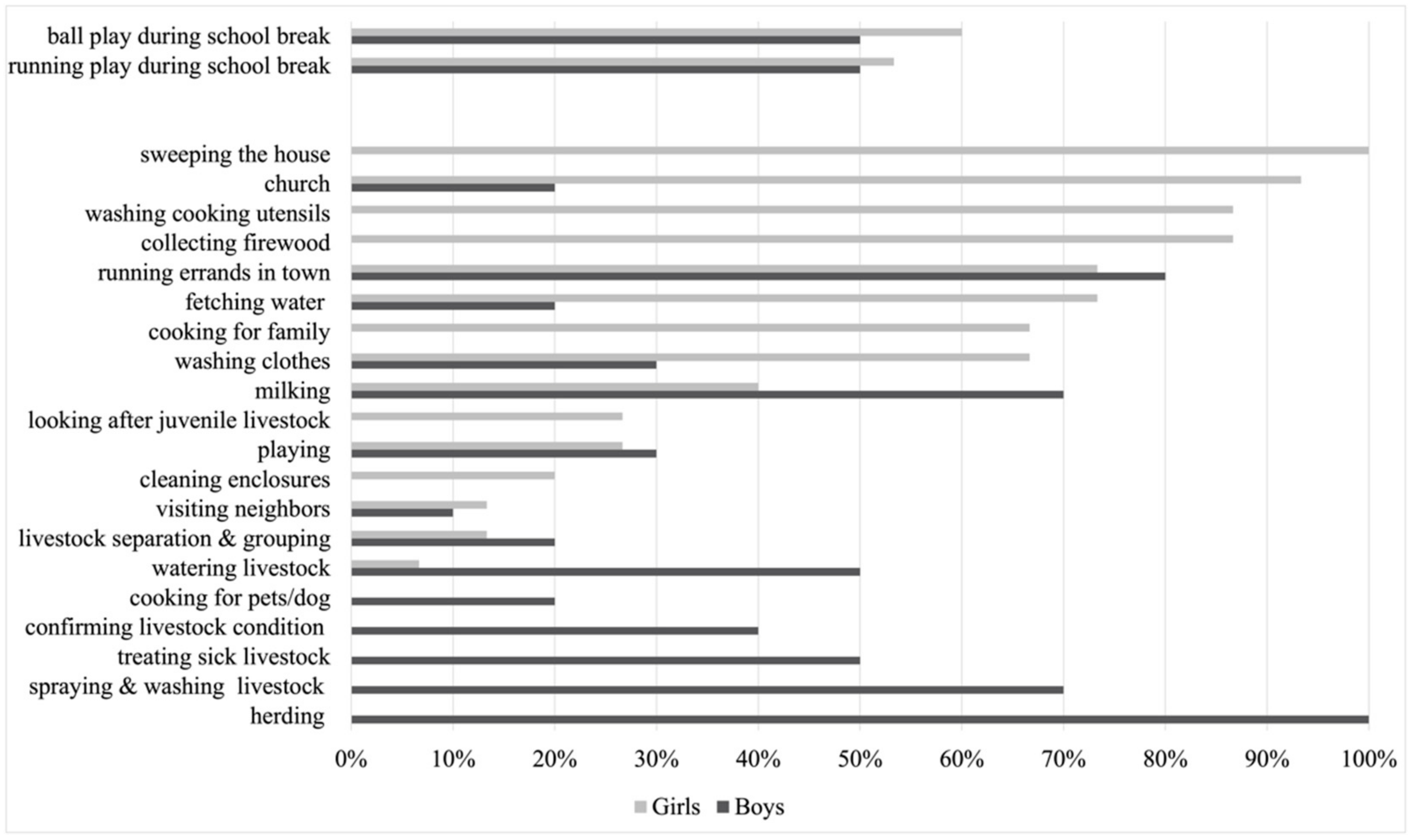Sociocultural Dimensions of Children’s Physical Activity in Contemporary Pastoralist Maasai Society
Abstract
1. Introduction
1.1. The Under-Investigated Children in Current Physical Activity Discussions
1.2. Ascertaining Maasai Children’s CPA from a Biosocial Approach
1.3. Pastoralist Maasai and Their Children
2. Study Area and Research Methods
3. Results
3.1. Physical Activity of Maasai Children
3.2. Daily Activities in and Outside School
3.3. Frequency, Locations, and Companions
4. Discussion
5. Conclusions
Author Contributions
Funding
Institutional Review Board Statement
Informed Consent Statement
Acknowledgments
Conflicts of Interest
References
- Bauman, A.E.; Reis, R.S.; Sallis, J.F.; Wells, J.C.; Loos, R.J.F.; Martin, B.W.; Alkandari, J.R.; Andersen, L.B.; Blair, S.N.; Brownson, R.C.; et al. Correlates of physical activity: Why are some people physically active and others not? Lancet 2012, 380, 258–271. [Google Scholar] [CrossRef]
- Blair, S.N. Physical inactivity: The biggest public health problem of the 21st Century. J. Sci. Med. Sport 2009, 10, 29. [Google Scholar] [CrossRef][Green Version]
- Guthold, R.; Stevens, G.A.; Riley, L.M.; Bull, F.C. Global trends in insufficient physical activity among adolescents: A pooled analysis of 298 population-based surveys with 1·6 million participants. Lancet Child Adolesc. Health 2020, 4, 23–35. [Google Scholar] [CrossRef]
- Hallal, P.C.; Andersen, L.B.; Bull, F.C.; Guthold, R.; Haskell, W.; Ekelund, U.; Alkandari, J.R.; Bauman, A.E.; Blair, S.N.; Brownson, R.C.; et al. Global physical activity levels: Surveillance progress, pitfalls, and prospects. Lancet 2012, 380, 247–257. [Google Scholar] [CrossRef]
- Trost, S.; Blair, S.N.; Khan, K.M. Physical inactivity remains the greatest public health problem of the 21st century: Evidence, improved methods and solutions using the ‘7 investments that work’ as a framework. Br. J. Sports Med. 2014, 48, 169–170. [Google Scholar] [CrossRef]
- Utesch, T.; Dreiskämper, D.; Strauss, B.; Naul, R. The development of the physical fitness construct across childhood. Scand. J. Med. Sci. Sports 2018, 28, 212–219. [Google Scholar] [CrossRef] [PubMed]
- Ortega, F.B.; Ruiz, J.R.; Castillo, M.J.; Sjöström, M. Physical fitness in childhood and adolescence: A powerful marker of health. Int. J. Obes. 2008, 32, 1–11. [Google Scholar] [CrossRef]
- Schwarzfischer, P.; Weber, M.; Gruszfeld, D.; Socha, P.; Luque, V.; Escribano, J.; Xhonneux, A.; Verduci, E.; Mariani, B.; Koletzko, B.; et al. BMI and recommended levels of physical activity in school children. BMC Public Health 2017, 17, 595. [Google Scholar] [CrossRef] [PubMed]
- Bryan, S.N.; Tremblay, M.S.; Pérez, C.E.; Sc, B.; Ardern, C.I.; Katzmarzyk, P.T. Physical Activity and Ethnicity: Evidence from the Canadian Community Health Survey. Can. J. Public Health 2014, 97, 271–276. [Google Scholar] [CrossRef]
- Gill, J.M.; Celis-Morales, C.; Ghouri, N. Physical activity, ethnicity and cardio-metabolic health: Does one size fit all? Atherosclerosis 2014, 232, 319–333. [Google Scholar] [CrossRef] [PubMed]
- Jiang, H.; Pongvongsa, T.; Yonto, D.; Moji, K.; Lin, L. Activity Space, Neighborhood Built Environment, and Physical Activity: A Pilot Study from a Rural Community in the Lao People’s Democratic Republic. J. Transp. Health 2018, 9, S27. [Google Scholar] [CrossRef]
- Shropshire, J.; Carroll, B. Family Variables and Children’s Physical Activity: Influence of Parental Exercise and Socio-economic Status. Sport Educ. Soc. 1997, 2, 95–116. [Google Scholar] [CrossRef]
- Varela, A.R.; Cruz, G.I.N.; Hallal, P.; Blumenberg, C.; da Silva, S.G.; Salvo, D.; Martins, R.; da Silva, B.G.C.; Resendiz, E.; del Portillo, M.C.; et al. Global, regional, and national trends and patterns in physical activity research since 1950: A systematic review. Int. J. Behav. Nutr. Phys. Act. 2021, 18, 35. [Google Scholar] [CrossRef] [PubMed]
- Chaput, J.-P.; Gray, C.; Poitras, V.J.; Carson, V.; Gruber, R.; Olds, T.; Weiss, S.K.; Gorber, S.C.; Kho, M.; Sampson, M.; et al. Systematic review of the relationships between sleep duration and health indicators in school-aged children and youth. Appl. Physiol. Nutr. Metab. 2016, 41, S266–S282. [Google Scholar] [CrossRef] [PubMed]
- Lambert, E.V.; Kolbe-Alexander, T.; Adlakha, D.; Oyeyemi, A.; Anokye, N.K.; Goenka, S.; Mogrovejo, P.; Salvo, D. Making the case for ‘physical activity security’: The 2020 WHO guidelines on physical activity and sedentary behaviour from a Global South perspective. Br. J. Sports Med. 2020, 54, 1447–1448. [Google Scholar] [CrossRef] [PubMed]
- Strain, T.; Wijndaele, K.; Garcia, L.; Cowan, M.; Guthold, R.; Brage, S.; Bull, F.C. Levels of domain-specific physical activity at work, in the household, for travel and for leisure among 327 789 adults from 104 countries. Br. J. Sports Med. 2020, 54, 1488–1497. [Google Scholar] [CrossRef]
- Mwangi, B.N.; Ong’ang’a, R.B.; Wamutitu, J. Relationship Between Institutional Factors and Implementation of Physical Education Curriculum in Private Primary Schools in Kajiado North Sub-County, Kajiado County, Kenya. IRJBP J. Educ. Pract. 2019, 2, 68–77. [Google Scholar]
- Froehle, A.W.; Wells, G.K.; Pollom, T.R.; Mabulla, A.Z.P.; Lew-Levy, S.; Crittenden, A.N. Physical activity and time budgets of Hadza forager children: Implications for self-provisioning and the ontogeny of the sexual division of labor. Am. J. Hum. Biol. 2019, 31, e23209. [Google Scholar] [CrossRef]
- Hagino, I.; Yamauchi, T. High Motivation and Low Gain: Food Procurement from Rainforest Foraging by Baka Hunter-Gatherer Children. In Social Learning and Innovation in Contemporary Hunter-Gatherers; Springer: Tokyo, Japan, 2016; pp. 135–144. [Google Scholar]
- Crittenden, A.N.; Zes, D.A. Food Sharing among Hadza Hunter-Gatherer Children. PLoS ONE 2015, 10, e0131996. [Google Scholar] [CrossRef]
- Sallis, J.F.; Owen, N.; Fisher, E.B. Ecological Models of Health Behavior. In Health Behavior and Health Education: Theory, Research, and Practice; Glanze, K., Rimer, B.K., Viswahath, K., Eds.; Jossy-Bass: Hoboken, NJ, USA, 2008; pp. 465–486. [Google Scholar]
- Homewood, K.; Trench, P.C.; Kristjanson, P. Staying Maasai? Pastoral Livelihoods, Diversification and the Role of Wildlife in Development. In Staying Maasai? Livelihoods, Conservation and Development in East African Rangelands; Homewood, K., Kristjanson, P., Trench, P.C., Eds.; Springer: New York, NY, USA, 2009; pp. 369–408. [Google Scholar]
- Woodhouse, E.; Mccabe, J. Well-being and conservation: Diversity and change in visions of a good life among the Maasai of northern Tanzania. Ecol. Soc. 2018, 23, 43. [Google Scholar] [CrossRef]
- BurnSilver, S. Pathways of Continuity and Change: Diversification, Intensification and Mobility in Maasailand, Kenya. Ph.D. Dissertation, Colorado State University, Denver, CL, USA, 2007. [Google Scholar]
- Spencer, P. Time, Space, and the Unknown: Maasai Configurations of Power and Providence; Routledge: Oxfordshire, UK, 2003. [Google Scholar]
- Tian, X. Day-to-Day Accumulation of Indigenous Ecological Knowledge: A Case Study of Pastoral Maasai Children in Southern Kenya. Afr. Study Monogr. 2016, 37, 75–102. [Google Scholar] [CrossRef]
- Tian, X. Ethnobotanical knowledge acquisition during daily chores: The firewood collection of pastoral Maasai girls in Southern Kenya. J. Ethnobiol. Ethnomed. 2017, 13, 2. [Google Scholar] [CrossRef]
- Ngugi, M. Challenges Facing Mobile Schools among Nomadic Pastoralists: A Case Study of Turkana County, Kenya. Am. J. Educ. Res. 2016, 4, 22–32. [Google Scholar]
- Dyer, C. Nomads and Education for All: Education for development or domestication? Comp. Educ. 2001, 37, 315–327. [Google Scholar] [CrossRef]
- Sifuna, D.N. Increasing Access and Participation of Pastoralist Communities in Primary Education in Kenya. Int. Rev. Educ. 2005, 51, 499–516. [Google Scholar] [CrossRef]
- Ng’Asike, J.T. Indigenous knowledge practices for sustainable lifelong education in pastoralist communities of Kenya. Int. Rev. Educ. 2019, 65, 19–46. [Google Scholar] [CrossRef]
- Galaty, J.G. Cattle and cognition: Aspects of Maasai practical reasoning. In The Walking Larder: Patterns of Domestication, Pastoralism, and Predation; Routledge: Oxfordshire, UK, 2014; pp. 215–230. [Google Scholar]
- Kimondo, J.; Miaron, J.; Mutai, P.; Njogu, P. Ethnobotanical survey of food and medicinal plants of the Ilkisonko Maasai community in Kenya. J. Ethnopharmacol. 2015, 175, 463–469. [Google Scholar] [CrossRef] [PubMed]
- Maundu, P.; Berger, D.; Saitabo, C.O.; Nasieku, J.; Kipelian, M.; Mathenge, S.; Morimoto, Y.; Hoft, R. Ethnobotany of the Loita Maasai: Towards Community Management of the Forest of the Lost Child, Experiences from the Loita Ethnobotany Project, People and Plants Working Paper 8; UNESCO: Paris, France, 2001. [Google Scholar]
- Evenson, K.R.; Catellier, D.J.; Gill, K.; Ondrak, K.S.; McMurray, R.G. Calibration of two objective measures of physical activity for children. J. Sports Sci. 2008, 26, 1557–1565. [Google Scholar] [CrossRef] [PubMed]
- Freedson, P.; Pober, D.; Janz, K.F. Calibration of Accelerometer Output for Children. Med. Sci. Sports Exerc. 2005, 37, S523–S530. [Google Scholar] [CrossRef]
- Mâsse, L.; Fuemmeler, B.; Anderson, C.B.; Matthews, C.; Trost, S.; Catellier, D.J.; Treuth, M. Accelerometer Data Reduction: A Comparison of Four Reduction Algorithms on Select Outcome Variables. Med. Sci. Sports Exerc. 2005, 37, S544–S554. [Google Scholar] [CrossRef] [PubMed]
- Trost, S.G.; Pate, R.R.; Freedson, P.S.; Sallis, J.F.; Taylor, W.C. Using objective physical activity measures with youth: How many days of monitoring are needed? Med. Sci. Sports Exerc. 2000, 32, 426–431. [Google Scholar] [CrossRef] [PubMed]
- Lancy, D.F. Anthropological Perspectives on Children as Helpers, Workers, Artisans, and Laborers; Palgrave Macmillan: London, UK, 2018. [Google Scholar]
- Spittler, G.; Bourdillon, M.F.C. African Children at Work: Working and Learning in Growing Up for Life; LIT Verlag Münster: Münster, Germany, 2012. [Google Scholar]



| Activities | Routine | Location | Companion (s) | ||
|---|---|---|---|---|---|
| None | With Children | With Adults | |||
| playing ball (in school) | weekdays | school | - | children | - |
| running | weekdays | school | - | children | - |
| herding | weekends | forest | - | boys | - |
| collecting firewood | weekends | forest | - | girls | female adults |
| watering livestock | daily | village | - | brothers/sisters | - |
| fetching water | daily | village | - | brothers/sisters | mother |
| spray and wash livestock | occasionally | village | - | brothers | father/mother |
| visiting neighbors | weekends | village | alone | - | - |
| running errands in town | daily | village | alone | sisters | - |
| confirming livestock condition | daily | home | alone | brothers | - |
| looking after juvenile livestock | daily | home | - | brothers | - |
| treating sick livestock | occasionally | home | alone | - | father |
| milking | daily | home | - | brothers/sisters | mother |
| cooking for pets/dog | daily | home | alone | - | - |
| livestock separation and grouping | daily | home | alone | brothers/sisters | mother |
| washing clothes | daily | home | alone | sisters | - |
| washing cooking utensils | daily | home | alone | sisters | - |
| sweeping the house | daily | home | alone | sisters | - |
| cleaning enclosures | weekends | home | - | brothers/sisters | mother |
| cooking for family | daily | home | alone | sisters | mother |
| playing | daily | home | - | children | - |
| church | weekends | village | - | children | all adults |
Publisher’s Note: MDPI stays neutral with regard to jurisdictional claims in published maps and institutional affiliations. |
© 2021 by the authors. Licensee MDPI, Basel, Switzerland. This article is an open access article distributed under the terms and conditions of the Creative Commons Attribution (CC BY) license (https://creativecommons.org/licenses/by/4.0/).
Share and Cite
Tian, X.; Kidokoro, T.; Mwangi, F.M. Sociocultural Dimensions of Children’s Physical Activity in Contemporary Pastoralist Maasai Society. Int. J. Environ. Res. Public Health 2021, 18, 8337. https://doi.org/10.3390/ijerph18168337
Tian X, Kidokoro T, Mwangi FM. Sociocultural Dimensions of Children’s Physical Activity in Contemporary Pastoralist Maasai Society. International Journal of Environmental Research and Public Health. 2021; 18(16):8337. https://doi.org/10.3390/ijerph18168337
Chicago/Turabian StyleTian, Xiaojie, Tetsuhiro Kidokoro, and Francis Mundia Mwangi. 2021. "Sociocultural Dimensions of Children’s Physical Activity in Contemporary Pastoralist Maasai Society" International Journal of Environmental Research and Public Health 18, no. 16: 8337. https://doi.org/10.3390/ijerph18168337
APA StyleTian, X., Kidokoro, T., & Mwangi, F. M. (2021). Sociocultural Dimensions of Children’s Physical Activity in Contemporary Pastoralist Maasai Society. International Journal of Environmental Research and Public Health, 18(16), 8337. https://doi.org/10.3390/ijerph18168337






